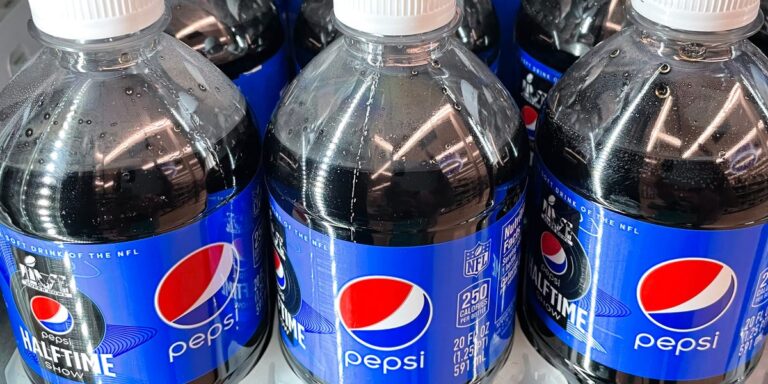- PepsiCo says it has completed two-thirds of its supply chain overhaul.
- The company has invested in AI and automation to make its production and distribution more profitable.
- This article is part of “The Future of Supply Chain Management,” a series on corporate manufacturing and distribution strategies.
Gregg Roden, PepsiCo’s chief operating officer, has spent his entire 34-year professional career at the snack food giant. He says he has seen more change in the past three years alone than in the previous 31.
For decades, as consumers bought more goods online, grocery sales remained steady in stores. But the pandemic has changed grocery shopping patterns, and people are now more likely to buy food and drinks online, too.
“When I started 34 years ago, everything was purchased in stores, and we had a fairly limited portfolio of choices for consumers,” Roden told Business Insider. “Now, anyone can buy anything, anywhere.” PepsiCo has also expanded its product line, offering new flavors and sizes for its snacks and beverages.
The shift means demand for more brands is coming from more directions. PepsiCo says it’s investing in digitization and automation — including robotics and predictive artificial intelligence — so it can better plan demand and produce and ship its products more quickly and precisely. And it says its supply chain transformation is two-thirds complete.
Supporting agriculture with AI predictive insights and satellite imagery
PepsiCo earned more than $91 billion in 2023 from sales of more than 500 brands worldwide, including its flagship sodas, Lay’s, Doritos, Gatorade and Mountain Dew. The company’s revenue for the first two quarters of 2024 topped Wall Street expectations, but volumes in North America for its Frito-Lay and beverage businesses have declined as consumers have resisted price increases for years.
Athina Kanioura, PepsiCo’s chief strategy and transformation officer, described investments in PepsiCo’s seed-to-shelf supply chain as the “glue” in the company’s future ability to generate higher profits and revenue growth. And it all starts with the work being done on the ground.
Farmers working with PepsiCo own more than 4 million acres of land in North America alone, providing ingredients like potatoes and corn for chips and other snacks.
The thinking is that by using less water and fertilizer to produce the ingredients, the company can boost its profits in an industry that operates on razor-thin margins. The company says it works with farmers to ensure they have the technology to harvest the ingredients efficiently and that it subsidizes some of the cost of that technology for smaller farms.
It also said it has partnered with companies including CropTrak, AgroScout and Microsoft to monitor production, analyse crop health, track where crops are growing and better understand where to plant crops to thrive.
Distribution workers do fewer manual tasks
PepsiCo is also rethinking how it fulfills orders and distributes its products, changing the jobs of many of the company’s employees in manufacturing and distribution. With more automation, workers are doing fewer physical tasks, such as driving forklifts, and much more oversight of the machines that take over those tasks.
Workers at manufacturing facilities and distribution centers and the unions that represent them often chafe at automation, which can lead to layoffs. Major food manufacturers that have announced closures and layoffs this year include PepsiCo, Tyson Foods and Campbell Soup. Often those announcing layoffs do not directly attribute them to automation but to sluggish sales, older facilities that can’t keep up with demand or even product recalls. PepsiCo declined to comment on the reasons for its layoffs.
Food manufacturers are also facing a generational shift. McKinsey research shows that while many Gen Zers express interest in working in manufacturing, not many are taking factory jobs to fill vacancies, and they are more likely to leave those jobs than older workers.
PepsiCo argued that it couldn’t continue to require employees to do most of the tasks manually while still producing enough food and beverages to meet demand. So it trained workers to monitor autonomous machines and make sure they were working safely and efficiently. “You’re taking analog workers, and you’re making them digital workers,” Kanioura said.
The company’s modernization efforts include the way it assembles various packages, such as those containing several small bags of Ruffles, Doritos, Cheetos and Fritos: Where workers used to assemble the packages, machines are increasingly taking over.
Even as it invests in automation, PepsiCo’s total workforce has swelled: It will grow by 20%, to 318,000, over the five years ending in 2023.
Creating a smarter warehouse
PepsiCo says it considers most of the company’s warehouses to be “smart” facilities with technology that allows employees to track and control the movement of goods.
PepsiCo uses sensors and AI to help with predictive maintenance checks and quality control measures — for example, using patterns to identify machines or vehicles that are likely to malfunction and cause problems later. Rather than shutting down production when a motor fails on a tortilla chip line, PepsiCo can preemptively replace the motor when the line is scheduled to be down.
“Being able to turn that data into action is critical,” Roden said.


